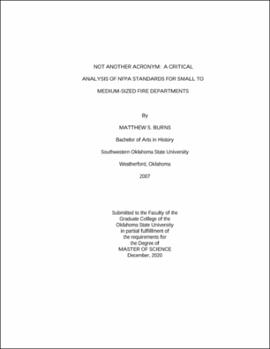| dc.description.abstract | The purpose of this study was to construct a framework of NFPAs to assist fire administrators in their daily implementation of policy and procedures. The central researcher question was "Can a framework be created to assist newly tenured fire chiefs in understanding what specific NFPA standards are needed in each division of a fire department?" Through the use of the interpretivist paradigm and a Qualitative method approach the purpose of the study was achieved. Within the Qualitative approach an inductive system of logic was used. The Delphi method which is qualitative in nature created the appropriate design of the study. The Delphi method was useful because experts were required to give their opinions on NFPA standards. It is subjective in nature, which follows the interpretivist paradigm. Semi-structured interviews were used to interview 6 participants. Purposive and snowball sampling were used in the selection of participants. The participants were experts in the understanding and use of NFPA standards. Synchronous online interviews (virtual face to face interviews) were completed via Zoom technology. A content analysis allowed for trending themes, concepts, categories, and keywords once interviews were completed. Descriptive, Interpretative, and theoretical validity were used in the study. The 3 areas of validity demonstrated what themes, concepts, categories, and keywords were used, which assisted with the conclusion and connection of the study's aim, objectives, and Central Research Question (CRQ). The study found there were 6 overarching themes. The themes included (Administrative NFPA standards), (Adopting NFPA standards), (Static NFPA standards), (Divisions), (Culture), (Comparing Small to medium sized fire departments to larger departments). Utilizing 4 of the 6 themes the researcher created a framework of 15 NFPA's that could be useful to newly tenured fire chiefs in small to medium sized fire departments. The themes of culture and adopting NFPA standards require soft skills from the fire chief to gently implement the standards to the department's specifications. Through the use of researcher tools, the author created a framework to assist fire administrators in their daily implementation of policy and procedures. Also, the 33% theory originated out of the analysis. The theory falls under organizational theory. | |
